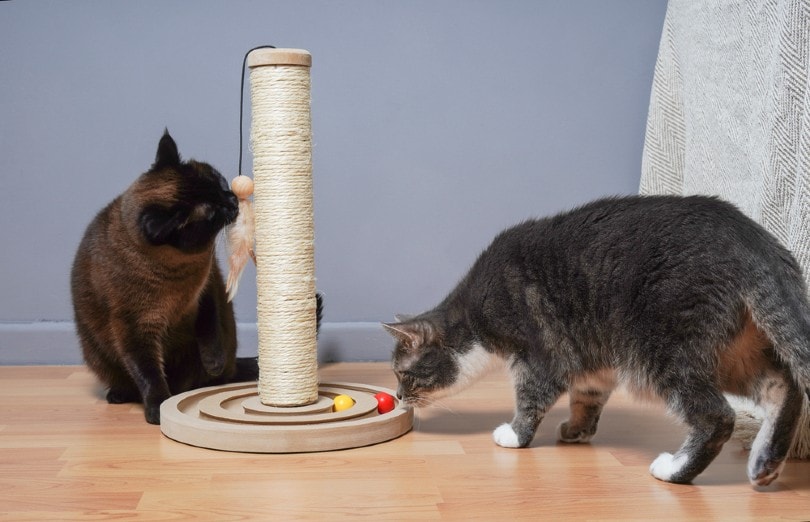
While many owners have wonderful stories of how having two cats is amazing, providing each cat with company and a playmate to keep them entertained, there are just as many horror stories of warring felines making their own lives and those of their owners a misery.
Generally, with a careful and patient introduction, two male cats can get along very well in the same house. And, even if the two don’t become closely bonded, even having the presence of another cat in the house can provide security and reassurance for both cats. Generally, male cats are more likely to get along if they are both neutered and it is always easier to introduce cats when they are both young.
One Cat Or Two?
If you currently have no cats and are considering getting one, many adoption centers and breeders advise getting two cats. They argue that this will provide company for both cats, which is especially beneficial when you are not at home but can also be beneficial because it provides them with feline company.
It can offer healthy play opportunities for both cats, too. If you are taking two cats from the same litter, however, you should consider getting two of the same gender and take steps to avoid the potential for littermate syndrome, which we discuss below. Overall, many owners do agree that two cats prove better than one.

Taking On a Second Cat
If you already have a cat at home and are considering getting a second cat, there are many factors to consider. If your cat is somewhat older, is well settled, and has never had other feline company, it may not be a good idea to get a second cat. Your original cat might feel threatened by the new arrival. Even if they don’t physically fight, bringing another cat into the house may lead to anxiety. It will take time to integrate the new cat. However, if your original cat is young, active, and well-socialized, getting a second cat can benefit everybody.
Matching Temperament
Try to match the temperament of a new cat to that of your existing feline companion. If you try to introduce a boisterous cat to a placid, laid-back cat, it can cause stress. It can be difficult to predict the temperament of a new cat, but if you are adopting, make sure you meet the new cat a few times before you take it home. This will give you a clearer picture of its temperament and activity levels.
Littermate Syndrome
When taking two or more kittens from the same litter, or even from different litters but of the same age, there is the risk that they will develop littermate syndrome. Littermate syndrome occurs when two cats become dependent on one another.
While it can seem cute that your cats get along really well, littermate syndrome can cause serious mental and emotional problems. One or both cats may become anxious when they are separated even for a short space of time. Prevent littermate syndrome by getting cats of a different age or by taking them on at different times, and ensuring that they don’t become too dependent on one another.

Tips To Introduce a New Cat To Your Home
1. Give Your New Cat Time
Your new cat is going to endure a lot of change in its life when it arrives. As well as meeting you and your family, it will need to get used to its surroundings. Forcing it to meet your existing cats and other pets may prove too much even for a level-headed, confident cat. Make sure your new cat has some space to call its own and let it settle in before you start the big introduction.
2. Take It Slowly
Don’t just throw the cats in a room and let them sort it out. Let the cats see one another and get used to the other’s presence before introducing them, if possible. This can be done using playpens or by letting them sniff at the door where the new family member is being kept. When introductions do start, make them gradual. The first few meetings should only last 5 or 10 minutes before you separate the cats and give them both their space.

3. Reward Positive Interaction
If the meeting goes well, praise both cats and give them a treat. This will act as positive reinforcement, so the cats will associate the meetings with these positive rewards. Over time, you can stop feeding treats, but they will be beneficial for now.
4. Don’t Push It
Even if the first couple of meetings go well, don’t be tempted to assume that the job is done. It only takes one negative experience to set the process back. Wait until the cats have been fully integrated before you leave them alone in the house with access to one another, or you may come back to warring felines.
5. Stay Calm
Cats pick up on the emotions of people, so if you are feeling and acting anxious, your cats will adopt these same emotions. Try to stay calm, even if you are feeling nervous. Be prepared, ensure that your new cat has an escape route to a safe place, and remember that if things don’t go well during the first introduction, that doesn’t mean all is lost.

Conclusion
Cats make excellent companions, and many people appreciate their independence as well as their loving nature. With that said a lot of cats really do benefit from having other feline company. They can learn from one another, play with one another, and even offer emotional support that we humans can’t offer. Having a second cat doesn’t necessarily mean you have to have twice the resources or space, either.
But, do think about your existing cat if you are considering adding a second feline companion. If your cat is old and has never really lived with other cats, it may be too much to expect them to adapt.
Featured Image Credit: Arina Krasnikova, Pexels







